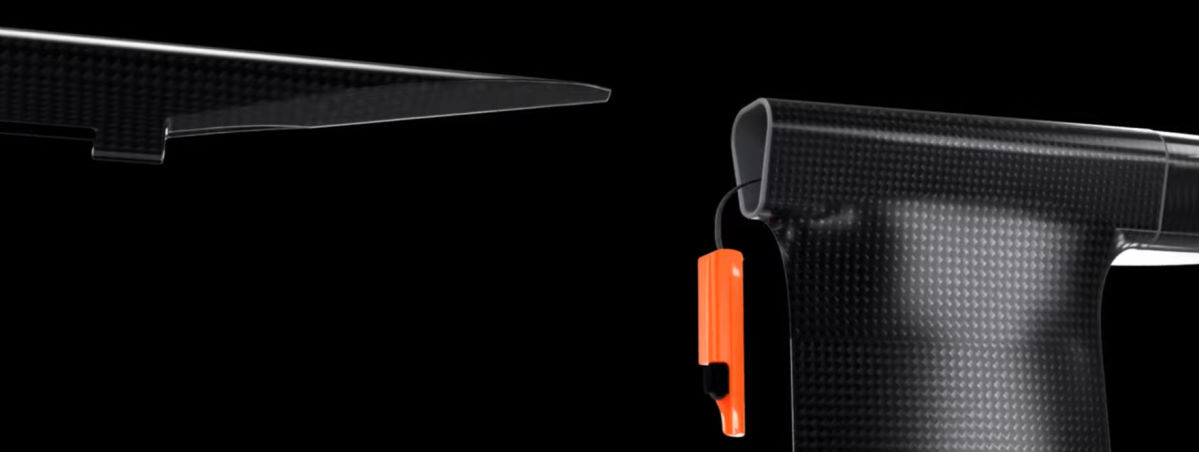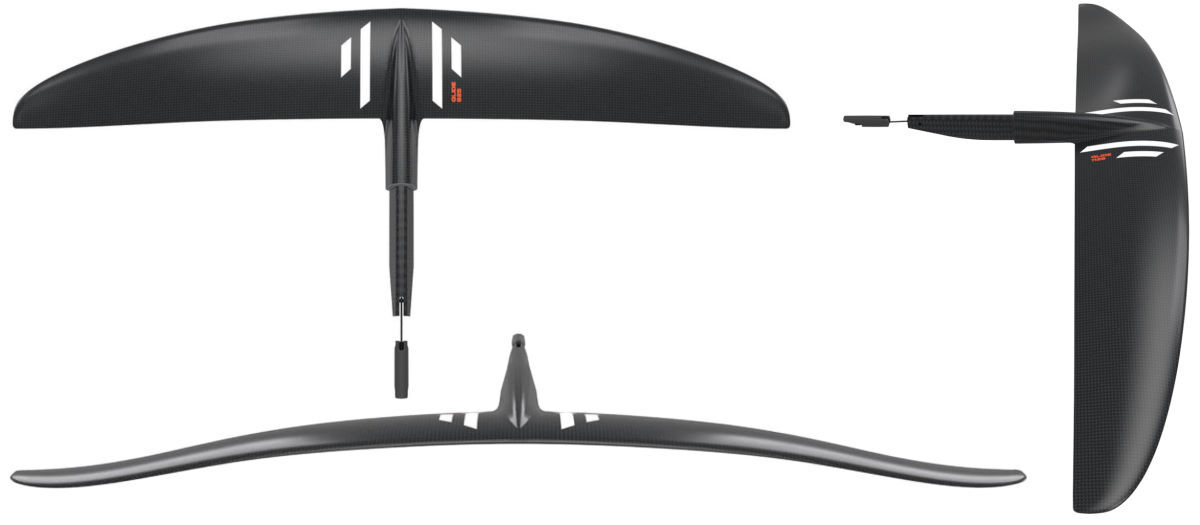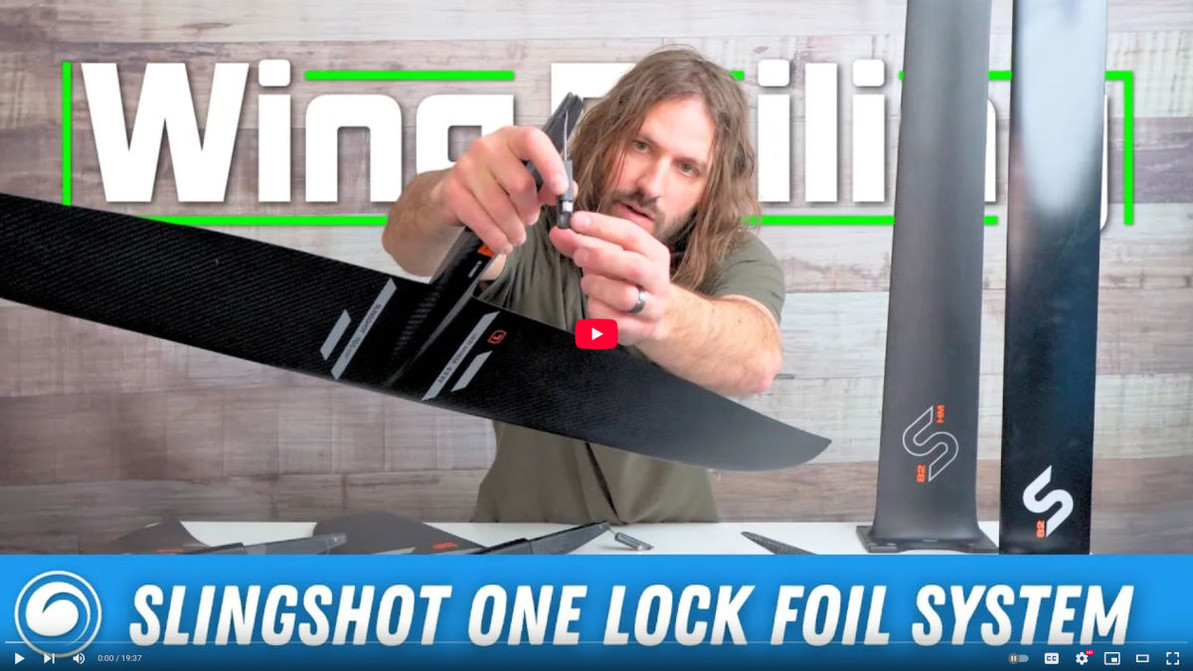Slingshot One-Lock System Overview - Gimmick or High Performance?
You've probably heard about Slingshot's toolless One-Lock System by now. You get to the beach, you put your front and back wing sections into the mast, lock it in, and off you go. That sounds amazing, but is it actually a good foil, or are you going to sacrifice quality and customizability for convenience?
Tucker's impressed with Slingshot for tackling some issues that foilers have come to accept as something that comes with the territory, specifically, the challenges that come with using hardware to assemble the components of your foil. Some have tried a one-piece design, but that's hard to travel with and isn't customizable, so it's not a good option for most riders.
But hardware gets lost, it corrodes, and it strips. It needs tools that also get lost and wear out. Slingshot refused to accept that this was a necessary evil and began development on something they hoped would be better. A few years later, we now have the One-Lock System.

One-Lock System
While the concept and execution are simple, there is some clever engineering in the design. The two pieces of the fuselage are wedge-shaped and nest together for a very tight fit the more they are pulled together. Even the mast collar that they fit into is triangular. All this ensures a stiff foil once assembled, yet one that still comes apart with just a little tap and wiggle.

The front and back wings are a monocoque design with the wing integrated into the fuselage. It's perfectly stiff and eliminates two sets of screws right there. These attach to the mast through a collar and lock with a lever. It's extremely fast and it's secure.

That in itself is a huge accomplishment, but Slingshot hasn't forgotten the connection to the board. They developed the Rapid Track System (RTS), which is also toolless once it's set up. The mast pedestal slides into a couple sled pieces that you position wherever you want in the track and tighten down. The mast slides into these, then you lock in the mast with two wing screws that tighten by hand. The wings can be lifted and locked into an orientation parallel to the flow of the water so that any drag is minimal. So there are a total of two screws to tighten in the whole setup, and those are toolless.

As great as all of this is, it only matters if it's a system you'd actually want to ride. Fortunately, Slingshot has years of foil design under its belt, and it's brought that to the table with its mast, front wing, and stabilizer offerings. It's a whole new ecosystem with everything available for it and all interchangeable with one another for a ride that you can customize as your needs and interests evolve.
Front Wings
Kite
The Kite front wing is currently available in three sizes from 755 to 1255 and is the lowest aspect ratio of the wing offerings. As the name implies, it's popular with kite foilers and works great in light wind and freeride. It doesn't need much speed to get on foil and has a surfy, shreddy feel.

Ease
The Ease is available in four sizes from 1250 to 2250 and is a medium to medium-low aspect wing. It bridges the gap between the Kite and the high-aspect Glide wings and is a true all-around wing. You can surf, wake, kite, wing, parawing... whatever you need to do, you can on the Ease.
As the name implies, it's an easy wing to ride, so it's accessible to new foilers. It's got good, but not aggressive, lift and is quite mellow. It's got just a little dihedral, which gives it an intuitive, flowy ride that isn't technical or twitchy. It isn't high-performance, but it's versatile and fun.

Glide
The Glide is an efficient high aspect wing. It comes in four sizes from 725 to 1325 and uses the carbon veil construction, which allows it to be thinner while remaining strong and stiff.
The Glide is the high-performance wing of the One-Lock System and provides the most range. It's ideal for winging, surfing, and downwinding. It's twitchier than the other two wing models, but it pays off in performance.
It's the most expensive of the wings due to its higher level construction, but this gives it the stiffness that the advanced riders who are going to gravitate towards this design want.

Stabilizers
Turbo
The Turbo tail is 180 cm2 and is the smallest of the three tails. It's Tucker's favorite to pair with any of the front wings. It's playful, maneuverable, and pumps well. It's not as stable or locked-in as the other options, so it's best for intermediate and advanced foilers.

Carve
The Carve is 200 cm2 and boosts performance by reducing lift and enhancing tail lock with its winglets. It's great for upwind and unlocks pitch. It's not for everyone, but it's fast.

Verse
The Verse is the most stable and predictable of the tails. If you're just starting your foil journey or prefer a relaxed ride that boosts confidence, this is a great choice. Its 270 cm2 size is enough to boost stability while still allowing you to work on your pumping and turning skills.

This range of stabilizers allows you to mix and match and get a completely different feel from your front wing. With how easy it is to swap out parts, it'll be more tempting than ever to pick up one of each to see how it affects your ride.
Masts
There are three mast constructions, and with a $1000 difference between the most and least expensive, it really comes down to your budget. That said, even the aluminum mast is no slouch on the water and offers a surprising amount of performance for the money. The Carbon and High Modulus Carbon masts feel similar but are increasingly stiffer for high speed riding, so choose the one that offers the performance you need but can still afford.
Each mast comes in a variety of sizes, from 72 - 92 for the carbon masts and 52 - 92 for the aluminum, in 10cm increments. If you ride at varying depths or swap among different disciplines, the aluminum mast has the best range of sizes, and at a price that allows you to buy more than one, though you can invest in the sizes available in carbon if you prefer.

Accessories
There really aren't a lot of accessories for the system because each part comes with everything you need. You get a cover for your front wing, your stabilizer, and your mast. Each front wing includes a replacement One-Lock latch. And the masts include the RTS system to connect to your board's track without tools. Slingshot has done a great job of making sure you have everything you need rather than leaving it up to you to make sure you picked up every little thing.

Tips, Tricks, and Reviews
We've already got some tips and tricks to help you get the most out of your One-Lock system, so if you're thinking about picking one of these up or already have, be sure to check those out. After we've logged a few more hours on it, we'll also have a review, though our first impressions have been quite positive. So far the One-Lock System seems to be the real deal and not just a toy for beginners. It's certainly accessible for new riders and packs a lot of tech into a reasonable price point, but it's got options for more demanding riders who are willing to invest in that as well. Stay tuned for more on this intriguing system!

MACkite Subscription Links:
YouTube | Instagram | Spotify Oddcasts
Contact MACkite Below:
800.622.4655 | Kiteboarder@MACkite.com | LIVE Chat Messenger

Recent Posts
-
Light Wind Kiteboarding Magic? The Reedin WhisperModel Might Be the Answer
Jeff from MACkite had a chance to meet up with Kevin Langeree of Reedin in Cape Town, South Afri …22nd Apr 2025 -
Hot New Releases: MACkite Brand Parawing & Mystic Majestic Ex Custom Harness
MACwing v.5 Beta Single Skin Single Use Jake and Ryan from MACkiteboarding unveiled an excit …1st Apr 2025 -
Code Foils 1250R, with Josh Ku and James Casey | Training, Gliding, and Light Wind Downwinding
Introduction: The Rise of the 1250R The Code Foils 1250R is the latest and largest addition to Co …1st Apr 2025




